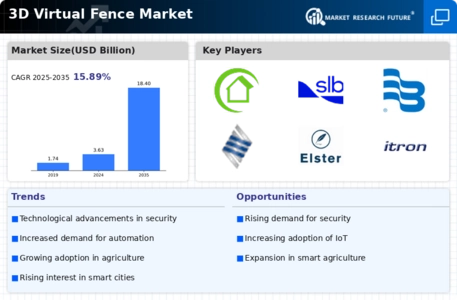Rising Security Concerns
The escalating concerns regarding security and safety are propelling the demand for innovative solutions within the 3D Virtual Fence Market. As urbanization increases, the need for effective perimeter security becomes paramount. Virtual fencing offers a flexible and cost-effective alternative to traditional fencing methods, allowing for dynamic adjustments based on specific security needs. The market is witnessing a surge in applications across various sectors, including residential, commercial, and industrial, as stakeholders seek to protect their assets. This trend is expected to contribute to a significant increase in market size, with estimates suggesting a potential market value exceeding 1 billion USD by 2027. The 3D Virtual Fence Market is thus positioned to address these pressing security challenges.
Technological Integration
The integration of advanced technologies such as artificial intelligence and machine learning into the 3D Virtual Fence Market is driving innovation and efficiency. These technologies enable real-time monitoring and adaptive responses to environmental changes, enhancing the functionality of virtual fencing solutions. As a result, the market is projected to grow at a compound annual growth rate of approximately 15% over the next five years. This growth is indicative of the increasing reliance on technology to manage land and livestock, suggesting that the 3D Virtual Fence Market is becoming more sophisticated and user-friendly. Furthermore, the ability to integrate with existing agricultural and security systems enhances the appeal of these solutions, making them more attractive to a broader range of users.
Environmental Sustainability
The growing emphasis on environmental sustainability is influencing the 3D Virtual Fence Market, as stakeholders seek eco-friendly alternatives to traditional fencing. Virtual fencing minimizes land disruption and reduces the carbon footprint associated with physical barriers. This aligns with global sustainability goals, appealing to environmentally conscious consumers and businesses. The market is likely to benefit from increased investments in sustainable technologies, with projections indicating a rise in market share for eco-friendly solutions. As more organizations adopt sustainable practices, the 3D Virtual Fence Market is expected to expand, potentially reaching a market valuation of over 800 million USD by 2026. This trend underscores the importance of aligning technological advancements with environmental stewardship.
Increased Agricultural Efficiency
The 3D Virtual Fence Market is experiencing a notable increase in adoption within the agricultural sector, driven by the need for enhanced efficiency and productivity. Farmers are increasingly utilizing virtual fencing to manage livestock and crops more effectively, allowing for precise control over grazing patterns and land use. This technology not only optimizes resource allocation but also reduces labor costs associated with traditional fencing methods. Market data indicates that the agricultural segment is expected to account for a significant portion of the overall market, with growth rates projected at around 12% annually. This trend highlights the potential of the 3D Virtual Fence Market to revolutionize agricultural practices and improve overall farm management.
Regulatory Support and Incentives
Government initiatives and regulatory support are playing a crucial role in the expansion of the 3D Virtual Fence Market. Various countries are implementing policies that encourage the adoption of innovative technologies in agriculture and land management. These initiatives often include financial incentives, grants, and subsidies aimed at promoting sustainable practices. As a result, stakeholders are more inclined to invest in virtual fencing solutions, knowing that they may receive support from governmental bodies. This regulatory environment is likely to foster growth within the market, with projections suggesting an increase in adoption rates among farmers and landowners. The 3D Virtual Fence Market stands to benefit significantly from this supportive landscape.


















Leave a Comment